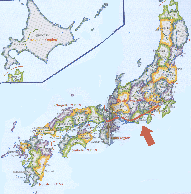
| Honjin |
Honjin originally means a place to stay for generals during wars, and the term was used as an officially appointed inns for daimyo or feudal lords. Honjin were used when daimyo went to or came from Edo due to sankin kootai, a system under which feudal loards in the Edo period were required to spend every other year in residence in Edo. There were 109 honjin on Tokaido, and besides daimyo, chokushi (Imperial messengers), shinno (Imperial princes), monzeki (head priests), or kugyoo (noblemen) were qualified to stay at honjin. There were also waki-honjin (sub honjin) which were used when more than one daimyo stayed in one shuku (station), and 67 waki-hinjin existed on Tokaido. Usually daimyo made honjin reservations about a couple of months before their arrival.
The biggest honjin on Tokaido was the Narumi shuku (shuku means inn) with the size of 676 tsubo (120 cars can park in this size). Masters of honjin were allowed to posses a sword and sir name (basically only samurai could have these).
 |
| Tokaido route |